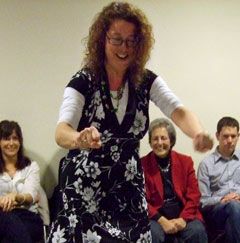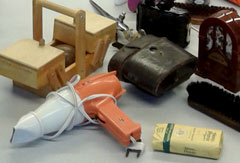Review of RTRT project: Spain - Alzheimer Catalunya

Memorable moments that took place in our RTRT group
-
“We always ask for feedback at the end of the session, and we recall and record special or “magic” moments of the meeting. This is very positive, since it helps us to evidence the relaxing moments and how they connect to each other”
We tried to help a woman, with moderately severe dementia, to reminiscence about her working experience through work-related object. We failed. Then, we decided to change the trigger to an old iron. She began to pretend she was ironing a pair of rousers and she was able to talk about it (2nd RTRT project).
-
In our first RTRT project there was a couple. He was suffering a moderate cognitive impairment. His wife told us that he wasn't really into dancing or enjoying too much in his lifetime. In one of the sessions we were reminiscing about old dances like the Twist, Rock and Roll, etc. The man was observing the situation and suddenly he started dancing the Twist. We discovered he had eye-contact with one of our professionals, and she had been encouraging him to dance. We could feel how surprised his wife was.
-
In our first RTRT project, in a meeting about home, we use a typical Catalan wine drinking bottle (porró). Every person with dementia found a connection with the “porró”. But we found an extremely successful moment. A man was touching and looking at the bottle for a long time, and suddenly he took it and did the movement to drink with an absolute expression of happiness.
The main things we have learned

Successes to build on:
-
 We need to do intensive work with the relatives in order to alleviate the daily struggle
We need to do intensive work with the relatives in order to alleviate the daily struggle -
We need to ask for external help to record the sessions in order to avoid being focussed on tasks apart from the main reminiscence work
-
We can successfully involve the front-line workers in nursing homes and residential care facilities in the reminiscence project. We found out they really appreciate the chance and the quality of their daily work improves as a result
Pitfalls to avoid:
-
We must not rush and must make enough time to maximise all the connections with the objects
-
We must delegate some tasks at every session, finding volunteers when necessary to help with record-keeping, etc., and keeping a clear sense of the priority of delivering effective reminiscence work
-
We need to be highly sensitive and aware to be able to contain the family carer and the person with dementia in the joint sessions
The main things that the carers in our groups learned about reminiscence

-
They learned to lower their expectations and observe the real impact of the reminiscence work. They learned to value the tiny little results instead of expecting very big changes
-
They found out about new memories they had not previously shared. They used memorable mementos with their relatives and shared joint memories in order to get closer to one another
-
They identified and learned to use new ways of communicating based on a relaxed and easy-going environment
What the people with dementia in our groups gained from the project:

-
“In the session about schooldays memories, we used theatre. There was always a priest to represent the remembered teacher of that time. It always had a positive impact. A participant asked us if the priest would come back in the future.. She showed a high wellness and happiness in this session”
They felt they had found a place to be involved in conversation and exchanges of common experience in a natural way avoiding feeling embarrassed
-
They found a place to feel reunited with their relatives
-
They found a place to socialise with no pressure
-
They felt they had found a place where they could be themselves
-
They felt that in the groups there was a space of respect of their daily reality, adjusted to their needs






